October Rainfall Came Eventually, But the Drought Continues
Key Points
- Exceptional (D4) Drought persists across southern Kansas (33% of the state) and Oklahoma (21%).
- Climate outlooks favor warmer and drier conditions than normal through the fall and early winter
- Drought in the Southern Plains is expected to remain and expand through winter
The U.S. Drought Monitor is updated each Thursday to show the location and intensity of drought across the country. Drought categories show experts’ assessments of conditions related to dryness and drought including observations of how much water is available in streams, lakes, and soils compared to usual for the same time of year.
This map shows drought conditions across the Southern Plains Drought Early Warning System as of October 25, 2022.
U.S. Drought Monitor Categories
Abnormally Dry (D0)
Abnormally Dry (D0) indicates a region that is going into or coming out of drought. View typical impacts by state.
Moderate Drought (D1)
Moderate Drought (D1) is the first of four drought categories (D1–D4), according to the U.S. Drought Monitor. View typical impacts by state.
Severe Drought (D2)
Severe Drought (D2) is the second of four drought categories (D1–D4), according to the U.S. Drought Monitor. View typical impacts by state.
Extreme Drought (D3)
Extreme Drought (D3) is the third of four drought categories (D1–D4), according to the U.S. Drought Monitor. View typical impacts by state.
Exceptional Drought (D4)
Exceptional Drought (D4) is the most intense drought category, according to the U.S. Drought Monitor. View typical impacts by state.
The U.S. Drought Monitor is updated each Thursday to show the location and intensity of drought across the country. Drought categories show experts’ assessments of conditions related to dryness and drought including observations of how much water is available in streams, lakes, and soils compared to usual for the same time of year.
This map shows drought conditions across the Southern Plains Drought Early Warning System as of October 25, 2022.
Current Drought Conditions and Outlook
October: A Month's Worth of Rain Came in One Storm for Eastern Oklahoma and North-Central Texas
- October precipitation was very much below average for all but western Texas until a couple of storms during the week of October 24–28 brought 1–5 inches of precipitation to eastern Oklahoma and northeastern Texas.
- Rather widespread 2+ inch rainfall totals across northern Texas and most of southern/eastern Oklahoma provided much needed drought relief and provide short -term improvement while also helping fill area reservoirs in advance of winter.
- The Choctaw Nation, which was in exceptional drought (D4), received over 2 inches in this single storm.
- So far, October temperatures have been above average for Kansas and Oklahoma. The highest temperatures across the region were recorded in the Choctaw Nation, where mean daily maximum temperatures have been over 4ºF above average over the last 30 days.
Precipitation (Inches) Since the October 18 U.S. Drought Monitor: October 18–26
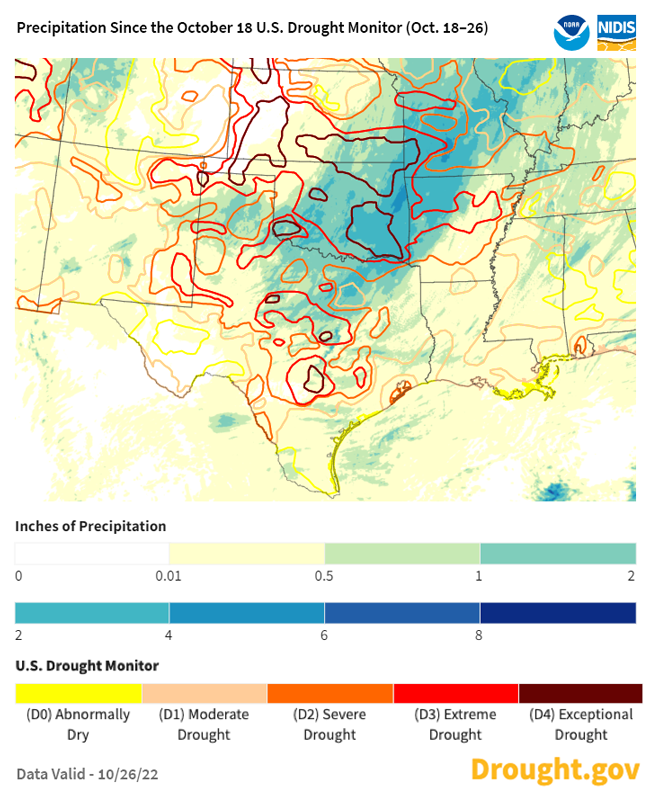
30-Day Departure from Normal Maximum Temperature (°F)
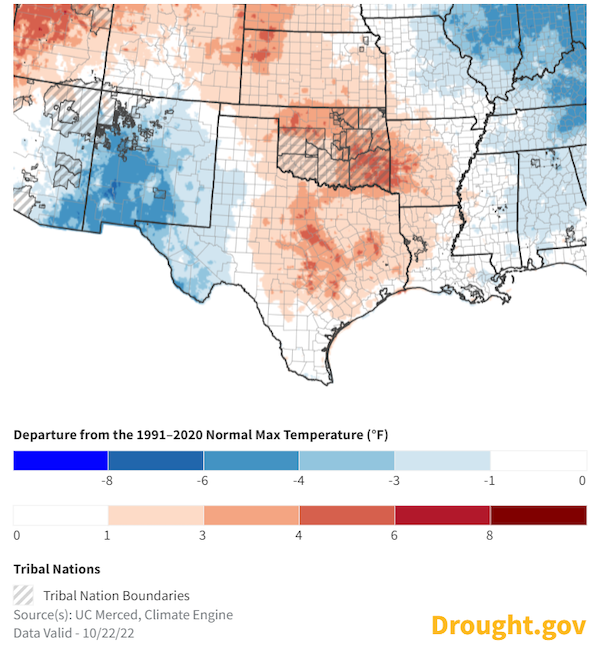
30-Day Percent of Normal Precipitation
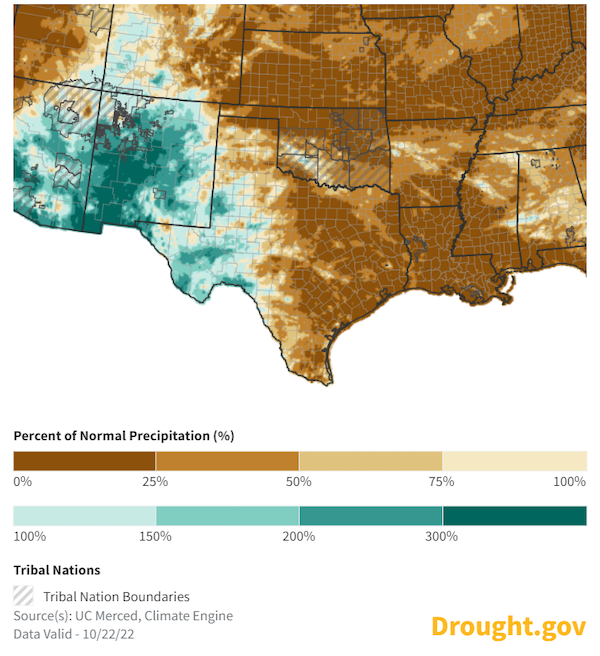
Total Precipitation in the 72 Hours from October 24–26
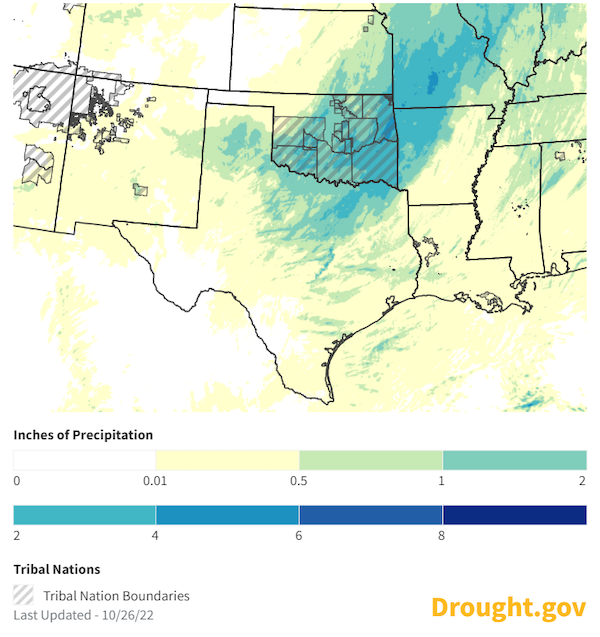
U.S. Drought Monitor Conditions
- 78% of the region is in drought (D1 or worse).
- 29% of the region is experiencing extreme (D3) drought or worse.
- 10% of the region is experiencing exceptional (D4) drought.
- 33% of Kansas is now in D4 status. That's the highest percentage of D4 since February 2013 and is currently the largest percent area in D4 for any U.S. state (Oklahoma is second at 21%).
- Extreme (D3) drought conditions have been in place in this region since August 2019.
- Moderate (D1) or worse drought has been in the region since June 2016.
- Over the last month, drought conditions have worsened over northern and eastern Texas.
- Exceptional (D4) drought has been in place for Oklahoma and southern Kansas since early September.
- Drought in New Mexico and western Texas improved, but was not eliminated, over the past month due to some late monsoonal showers in September.
U.S. Drought Monitor 4-Week Change Map
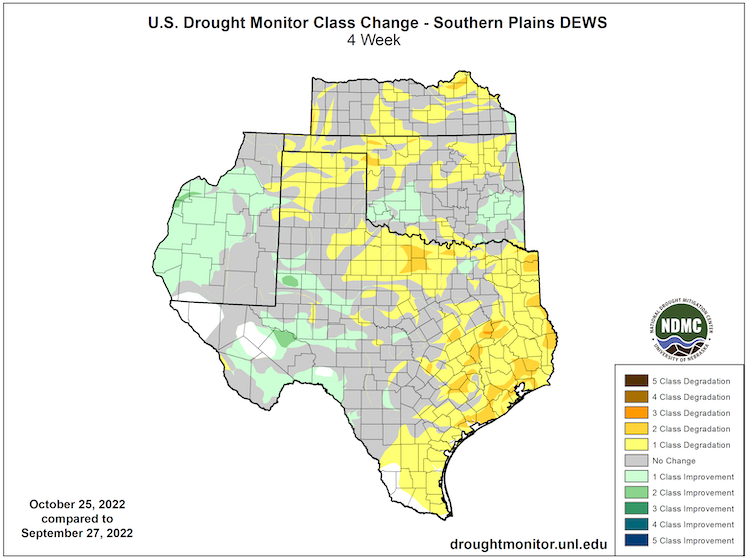
Forecasts and Seasonal Outlooks
November 2022
The Climate Prediction Center's monthly outlook for November shows:
- Increased temperatures are highly likely across most of the U.S., including the Southern Plains region, with the highest odds over Kansas and northern Oklahoma.
- The monthly precipitation outlook for October shows below-average precipitation is the most likely outcome for the whole region in October.
November 2022 Temperature Outlook
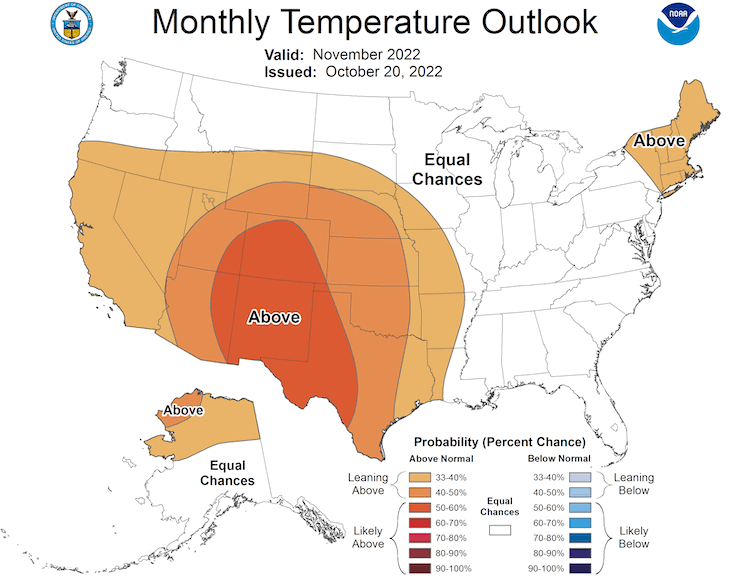
November 2022 Precipitation Outlook
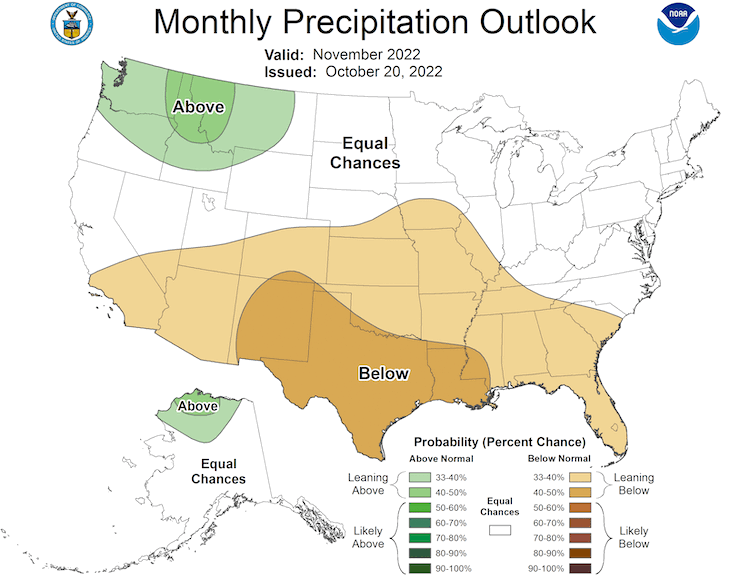
3-Month Outlook for November 2022–January 2023
Seasonal forecasts for November through January show a warmer and drier than normal season ahead for the Southern Plains.
Three-Month Temperature Outlook: November 2022–January 2023
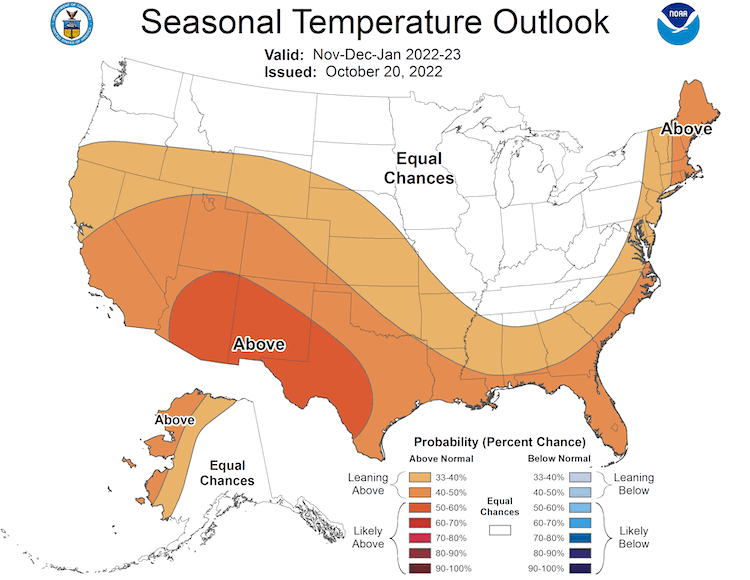
Three-Month Precipitation Outlook: November 2022–January 2023
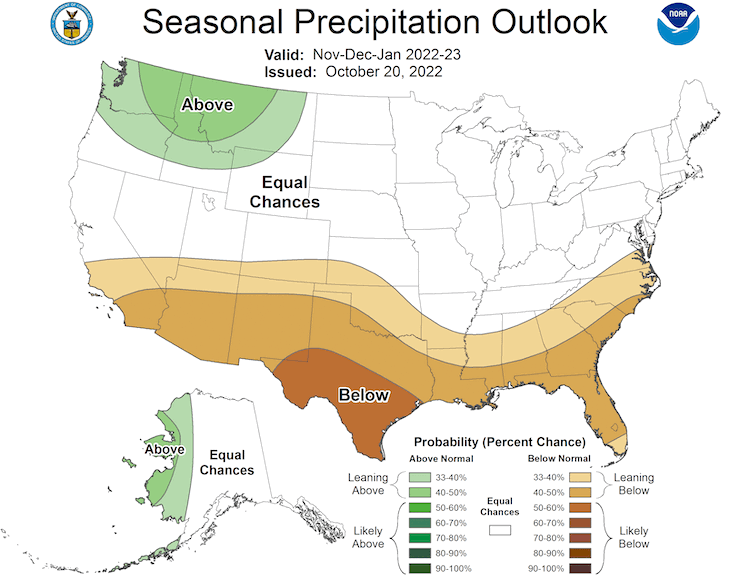
Seasonal Drought Outlook
With the Climate Prediction Center's seasonal outlook strongly favoring below-normal precipitation for Texas and generally favoring below-normal precipitation for Oklahoma and Kansas, the seasonal drought outlook shows continued or returning drought for the region this winter.
October 20–January 31 Drought Outlook
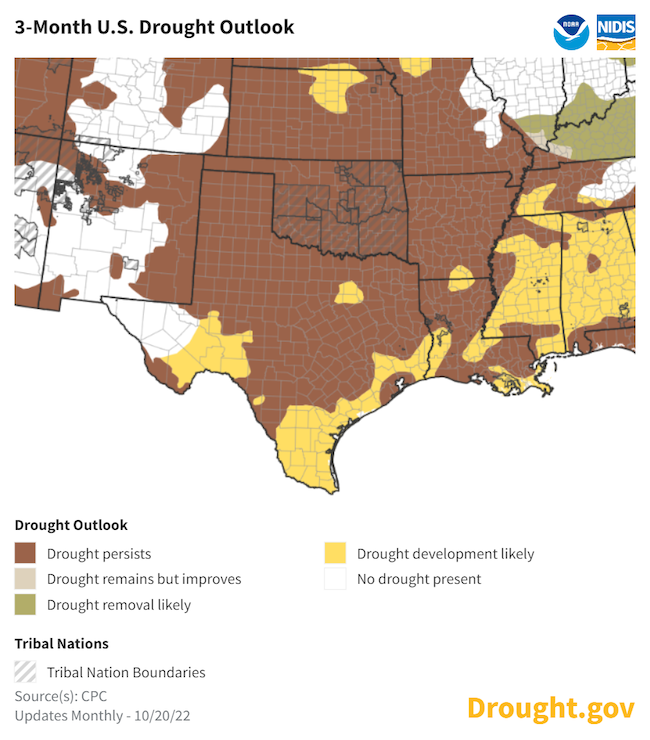
La Niña Persists and Will Impact Winter Weather
- One of the primary drivers of drought across the Southwest, including western Texas, through the winter ahead will be a third consecutive year of a La Niña pattern in the Pacific.
- The latest Climate Prediction Center El Niño Southern Oscillation (ENSO) discussion maintains a La Niña Advisory. There is a 75% chance of La Niña during the Northern Hemisphere winter (December–February) 2022–23, with a 54% chance for ENSO-neutral in February–April 2023.
- No two La Niña patterns are the same. For more information please check out the NOAA ENSO blog.
State-Based Conditions and Impacts
Kansas
- With recent widespread freeze, the growing season has concluded statewide, bringing an ease to water demands. However, aquifers and streams are slow to rebound if at all yet.
- Wheat emergence is sparse and at 11% below average. There are concerns about lack of moisture to sustain the wheat that did emerge.
- Increased wind combined with drought conditions have led to large wildfire activity statewide.
- Corn and soybeans are being bailed for feed as most fall hay has already been depleted.
- Moisture that has occurred has not been enough to offset even short term deficits. Very dry soils remain with dust concerns to cattle and road safety.
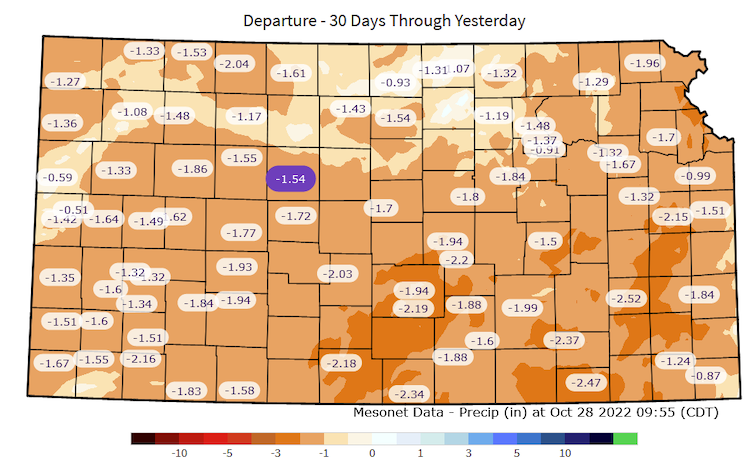
Oklahoma
- Significant rainfall has helped alleviate drought conditions across parts of southern and eastern Oklahoma.
- Much of the northern one-third of the state has missed out on the heavier rains, however.
- Northwestern Oklahoma has been particularly dry, with most areas seeing less than a half-inch for October thus far.
- Thirty Oklahoma counties remain with burn bans despite the rainfall.
- Oklahoma’s topsoil was considered 98% short to very short according to USDA estimates, although that number has improved due to recent rains.
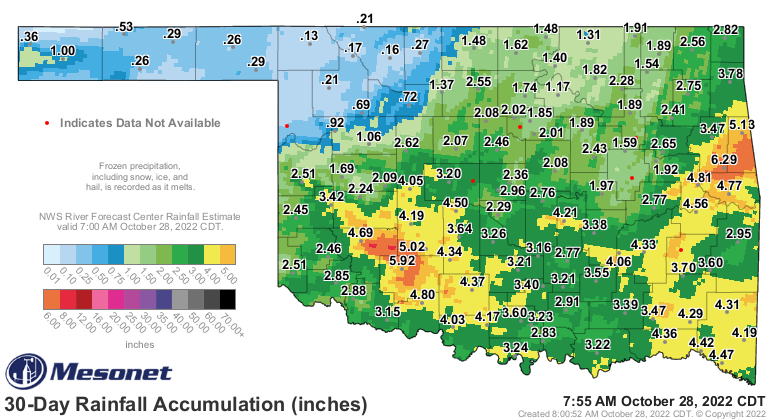
Texas
- Soil moisture levels remain low across most of the state, with the dry spell from early September to mid-October evaporating the water from the rains that fell in August.
- Throughout the state, ranchers continue to provide supplemental feeding for cattle.
- Winter wheat is being planted in the hopes that rains in late October will help get the wheat established.
- Cotton crop losses in the southern High Plains of Texas due to the drought were estimated at $2 billion dollars.
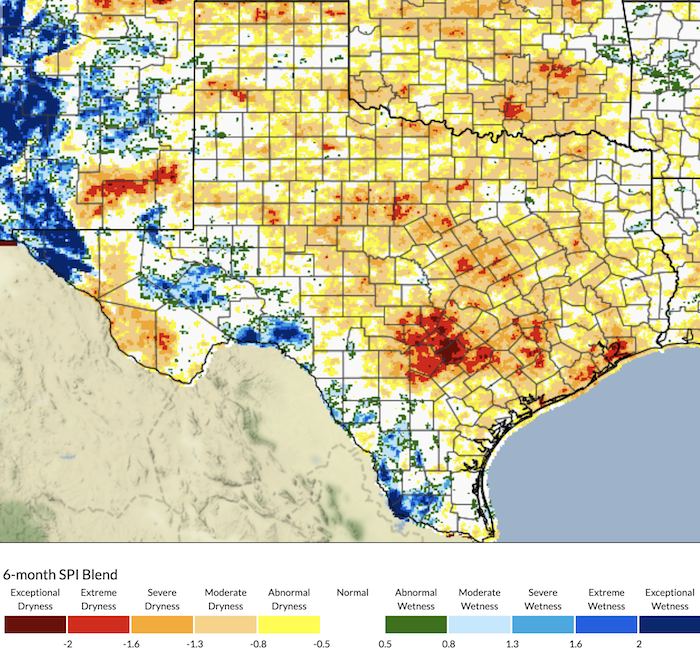
New Mexico
- New Mexico has drought conditions ranging from no drought to exceptional drought (D4):
- The short-term drought conditions have improved dramatically in much of the state due in part to lingering moisture in October, with many parts of western and central New Mexico receiving as much as 400% of normal rainfall in the past 30 days.
- Despite this, there are some areas where extreme (D3) and exceptional (D4) drought remain, particularly in the eastern plains and far northeast of the state.
- Long-term effects of drought are still very much present despite a robust monsoon season.
- Short-term groundwater and vegetation signals are showing clear signs of improvement.
- Some long-term drought signals, such as surface water storage, are showing the effects of decades of drought. This is particularly true along the Rio Grande where Caballo and Elephant Butte reservoirs are at 11% and 6% of capacity, respectively.
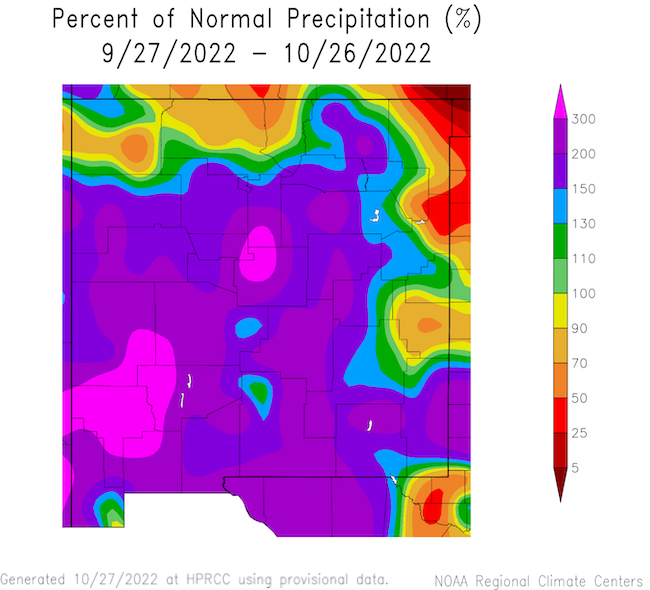
For More Information
NIDIS and its partners will issue future drought updates as conditions evolve.
More local information is available from the following resources:
Upcoming Events
- November 14, 2022, 1–3 p.m CST: Southeast Regional Climate Center Winter Drought Webinar. Registration link still to come.
Prepared By
Joel Lisonbee
NOAA/National Integrated Drought Information System (NIDIS), Southern Plains Drought Early Warning System and CIRES/CU Boulder
Gary McManus
Oklahoma State Climatologist, Oklahoma Mesonet, Oklahoma Climatological Survey
Chip Redmond
Kansas State University
Matthew Sittel
Kansas Assistant State Climatologist, Kansas State University
John Nielsen-Gammon
Texas State Climatologist, Texas A&M University
Southern Regional Climate Center
Victor Murphy
National Weather Service
This drought status update is issued in partnership between the National Oceanic and Atmospheric Administration (NOAA) and the offices of the state climatologist for Texas, Oklahoma, New Mexico, and Kansas. The purpose of the update is to communicate a potential area of concern for drought expansion and/or development within the Southern Plains based on recent conditions and the upcoming forecast. NIDIS and its partners will issue future drought updates as conditions evolve.








